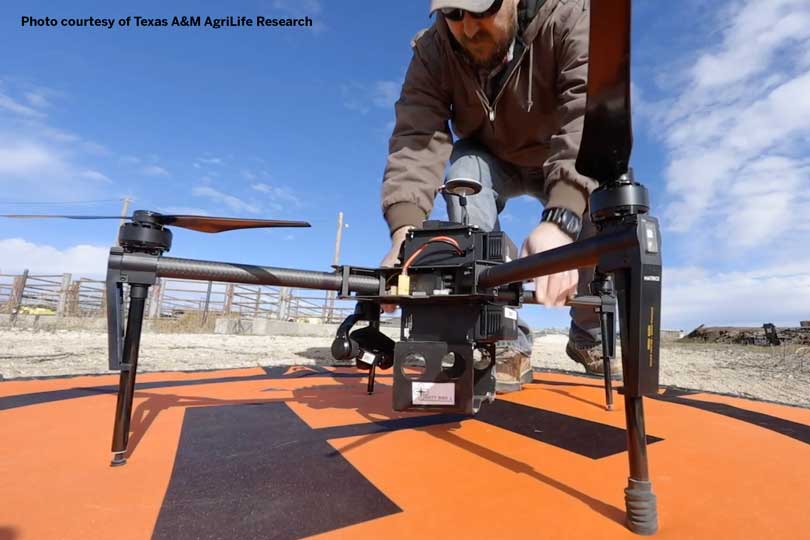By Jessica Domel
Multimedia Reporter
Instead of saddling the horse or starting up a vehicle, cowboys of the future may instead launch drones to monitor cattle health and behavior.
At the Texas A&M AgriLife Research and Extension Center in Amarillo, scientists are testing several different technologies that could make home on the range, or on the feedlot, much easier.
“What we’re trying to accomplish is to accelerate how we detect and respond to disease status or some other health status of the animals. Cowboys in a cattle feedlot, for example, already look at every animal every day from horseback. But is it possible for us to use some kind of remote sensing, whether it’s on a drone or fixed up high?” Dr. Brent Auvermann, director of the center, said in an interview with the Texas Farm Bureau Radio Network.
Researchers are trying to determine if it’s possible to use imaging techniques, digital video and other systems to identify livestock with signs of illness or poor feed-to-gain performance.
“Really the objective here is to identify animals earlier than we otherwise could,” Auvermann said. “Perhaps, for example, we can do it at night when we don’t have a lot of human beings in the feedlot. Maybe there’s evidence that shows up at night that we could detect using either drones or some other remote sensing technique.”
One technique being tested involves thermography via drone. Thermography has been used by veterinarians for years to detect issues like lameness in horses, but it’s been used close to the animal being examined—not from high in the sky.
This method would search for subtle temperature differences to help identify sick animals.
“Thermography is really looking at surface temperatures. In the same way, we take our children to the pediatrician now, and they can scan the child’s temple or the inside of their ear to get a temperature index for that child and compare it against what the normal ought to be, that’s essentially another way of using thermography,” Auvermann said.
But it can be used from a distance on several animals all at once with the help of artificial intelligence (AI).
The center is also researching whether AI may be used in conjunction with video cameras at a feedlot to survey animals.
“In a cattle feedlot, where you have a bunch of animals in confinement, you can mount video cameras—digital video cameras—up high and just continually monitor their behavior,” Auvermann said. “One of the things that we’re investigating—and this is a project that’s led out of College Station and they’re just conducting the research up here—is what behavioral cues can be extracted from a digital video loop to figure out if an animal is not eating consistently.”
The cameras will capture a lot of information, and that’s where AI comes in.
“It’s a ton of data. Images, by themselves, take megabytes. Video loops take gigabytes to terabytes, and so we have to have machines help us sort through them efficiently,” Auvermann said.
The idea, he explained, is to extend what farmers do in precision agriculture into animal production.
“We administer pesticides, we irrigate and we apply fertilizer, nitrogen phosphorous, et cetera,” Auvermann said. “If we can target the application of those inputs where they are, only where they are needed and only at the rate that they’re needed to accomplish our goals, then we can save money. We can liberate finances to be used in other areas of the operation.”
Although the research is still in the very early stages, it’s possible it could one day be used on a private ranch to monitor cattle health and behavior.
“I think all of agriculture is moving this way. I freely admit it may turn out that what we are able to do from a drone in a cattle feedlot can just as easily be done from a fixed platform way up high,” Auvermann said. “The main idea here is not the drone, per se, it’s the remote sensing and the data analytics that go along with it.”
The research is being conducted in coordination with Texas A&M University in College Station.

